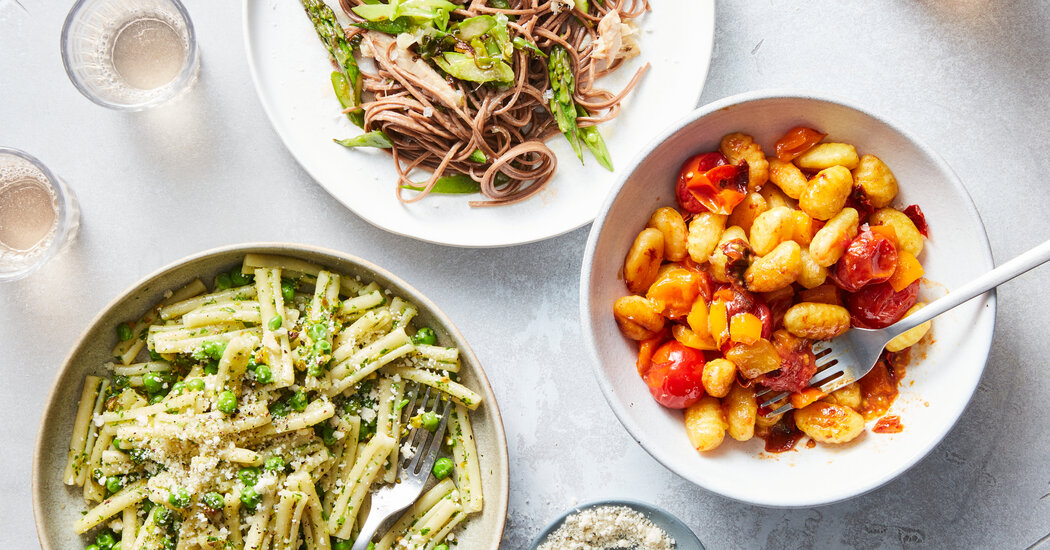
Think about all the ways tomatoes become pasta sauce — cherry tomatoes blister for a pasta salad, whole tomatoes simmer slowly into ragù. But swapping tomatoes for the springtime produce at the market or for the vegetables on their last legs in your fridge leads to so many possibilities for satisfying and exciting vegetable-focused pasta dishes.
With a little time and some pantry ingredients, many vegetables can end up saucy enough to coat noodles. Some sturdy ones, like broccoli or onions, might need to be cooked to submission. Others, like basil or sweet peas, don’t need to be cooked at all.
The techniques that follow combine the noodles lurking in your cabinet with fresh produce to maximize flexibility and flavor. These methods coax the best tastes and textures out of vegetables, so you can use what you have to cook what you feel like eating. These fast and loose ways for pulling together vegetable-driven meals are low on effort and high on reward. Just remember: Do more with less. Don’t overthink it. And also: It’s only dinner.
Break down produce to turn it into sauce.
The smaller the vegetable pieces, the more easily they collapse into sauce. You can grate juicy options like corn, tomatoes and summer squash. Leave small things like peas alone since you can smash them in the pot. Boil sturdy greens, then cool them in ice water and finely chop them to expedite their softening. Everything else (cauliflower, cabbage, brussels sprouts, leeks, shallots, fennel, mushrooms) can be thinly sliced or coarsely chopped.
Recipe: Skillet Broccoli Spaghetti
For especially sweet vegetables, slow-roast them.
The faster way to coating pasta with chopped vegetables is sautéing them on the stovetop, maybe with aromatics and definitely with salt, until they resemble sauce. Add the pasta and pasta water, and stir until the blend slicks the noodles.
The hands-off version happens in the oven: Roast vegetables and aromatics with a generous amount of olive oil until very soft. The vegetables will caramelize and concentrate, while the oil gets intensely delicious with whatever is swimming in it. Toss this jammy, oily mess with pasta water and it becomes sauce. (For a smoother texture, mash all of it up with a fork or a potato masher first.)
Recipe: Gnocchi With Roasted Peppers and Tomatoes
Rely on those not-so-secret ingredients: salt and time.
Since vegetables are mostly water, season them with enough salt to draw out that water, help them soften slightly and distill their natural flavors. This is especially important with an uncooked sauce. The longer the vegetables mingle with salt, fat and seasonings, the more intense the taste of the sauce.
Recipe: Spring Soba With Tinned Fish
Find bright spots for brown food.
A long-cooked vegetable is a flavorful vegetable, but it may also need some texture and freshness alongside it. Consider adding bracing, acidic ingredients to deeply caramelized ones. Stir a splash of wine or vinegar into a hot pan to scrape up the sticky browned bits while cooking, or grate cheese or lemon zest over the pasta just before serving. This is also a great place to toss in fresh, soft herbs, like mint, parsley or dill.
Recipe: Caramelized Zucchini Pasta
Make a fresh green sauce, any time of year.
Soft herbs and similar tender greens are reliably delicious and available anytime, which means a perky green sauce can be, too. To use up whatever you have on hand, combine 2 packed cups greens with 1 cup grated Parmesan, ½ cup nuts, ½ cup olive oil and some garlic. The greens can be parsley, basil, mint, dill, arugula, spinach, carrot tops or beet greens. Use a mix or just one, but know that some, such as mint and dill, are more flavorful than others, like parsley and spinach. The nuts, which add heft and creaminess, can be walnuts, hazelnuts, almonds, pistachios or pine nuts. (Keep them raw for a milder sauce.) You can swap the garlic for scallions, shallots, chives or other spring alliums. Chop all the ingredients together and it’ll smell like spring inside, too.
Recipe: Pasta With Chopped Pesto and Peas
This article is an excerpt from “I Dream of Dinner (So You Don’t Have To)” by Ali Slagle (Clarkson Potter, 2022).




